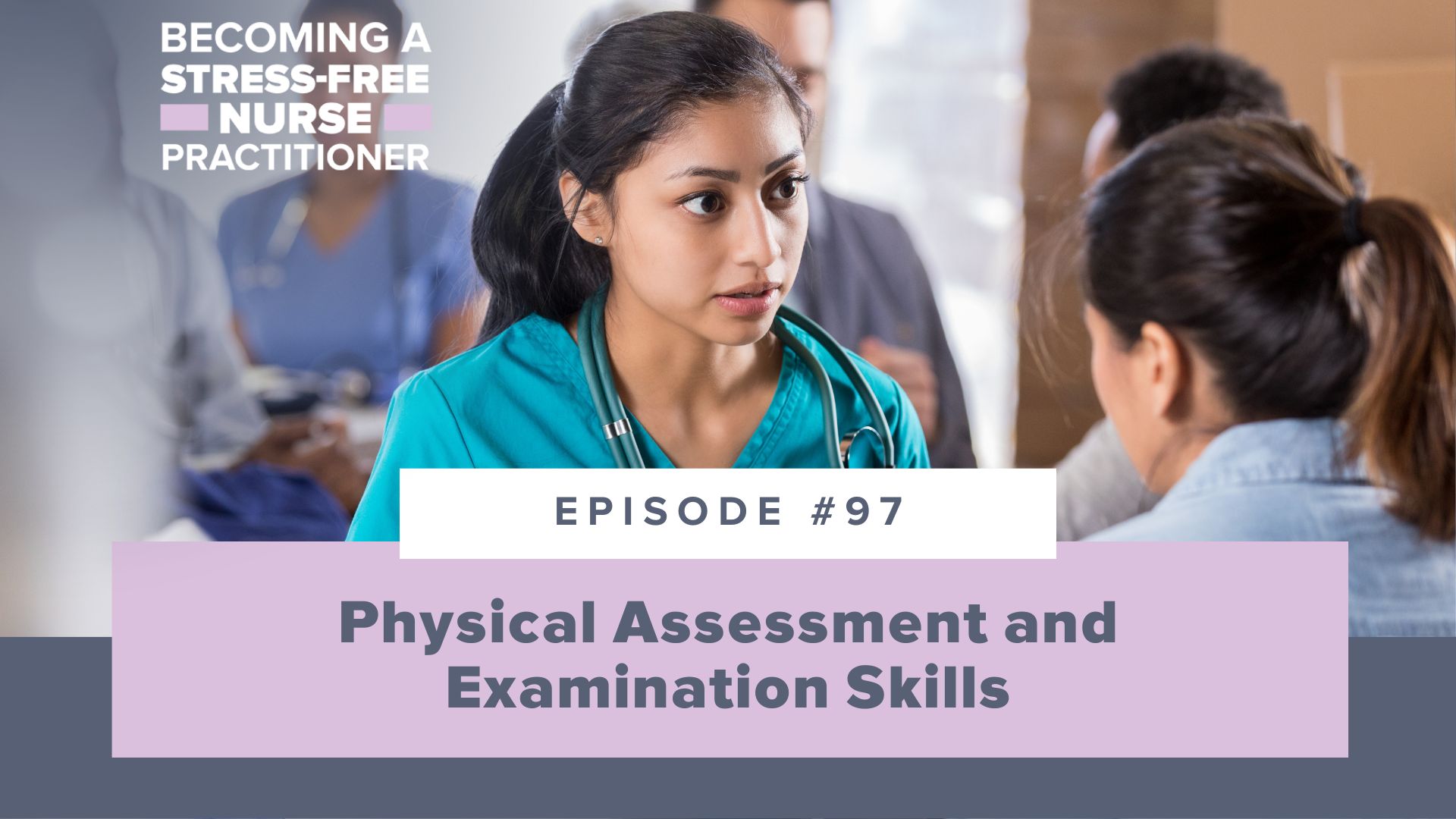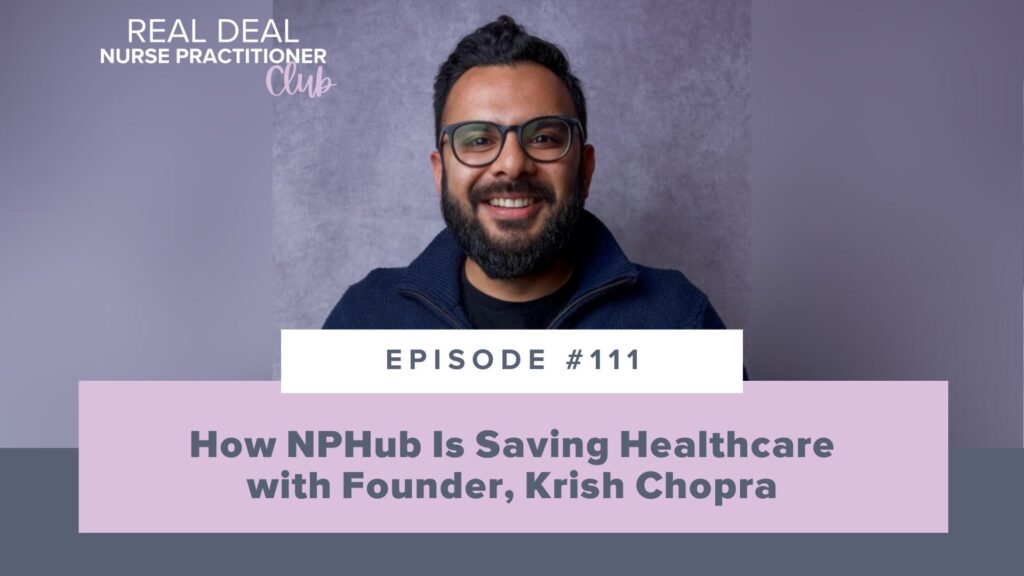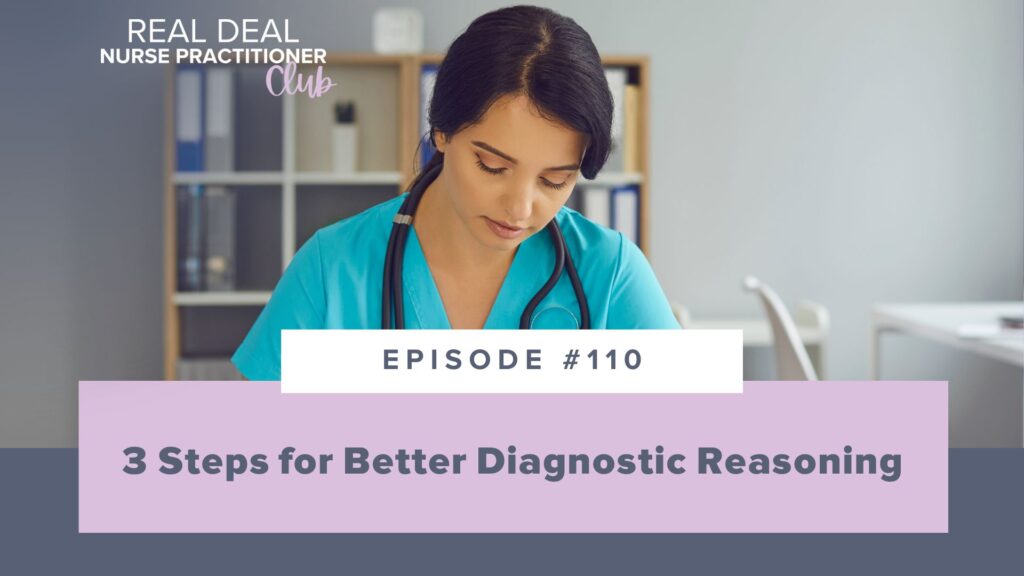Ep #97: Physical Assessment and Examination Skills
- by
- Oct 04, 2023
- Podcasts

Anna and I are talking about a topic that is at the very heart of nursing practice this week: physical assessment and examination skills. These skills are the cornerstone of effective patient care, diagnosis, decision making, and all the important things we do as Nurse Practitioners.
Physical assessments are a critical part of your job as an advanced care provider. You’re making differential diagnoses and creating a plan of care, and it’s a process that can take a long time to master. That’s why Anna and I are here to share our top tips for success from our own experiences.
Join us on this episode to learn how to get proficient in the physical assessment and examination of your patients. We’re sharing the difference between head-to-toe versus focused assessments, how to tailor your assessments to your patients, why documentation is crucial for communication, and how to be effective in your charting practices.
If you’re looking for support, no matter what phase of your nurse practitioner journey you’re currently in, I have communities available for both students and new nurse practitioners. In these communities, we work to uplift one another and grow this profession together every day, so click here to check them out!
What You Will Discover:
- The 4 basics of physical assessment.
- How to ensure nothing is overlooked during a physical assessment.
- The difference between head-to-toe versus focus assessments.
- Our tips and techniques for enhancing your physical assessment skills.
- 2 common challenges you might face in carrying out physical assessments.
- How to be effective in your charting practices.
Featured on the Show:
- If you’re looking for extra support, I have communities available for both students and new nurse practitioners. Click here if you’re a student, and click here if you’re a new NP!
- Follow me on: Facebook | Instagram | YouTube | TikTok
Full Episode Transcript:

Welcome to Becoming a Stress-Free Nurse Practitioner, a show for new NPs and students that want to pass their board exam the first time and make that transition from RN to NP as seamless as possible. I’m your host Sarah Michelle. Now, let’s dive into today’s episode.
Sarah: Hey y’all. Today on this podcast me and Anna, we are talking about a topic that is just the very heart of nursing practice. And that is physical assessment and examination skills. Now these skills are really just the cornerstone of effective patient care, diagnosis, decision making, all the important things that we do as nurse practitioners.
And in this episode we’re going to talk about head to toe versus focused assessments and just share some tips and techniques for success and from our own experience. And as nurses and nurse practitioners you all know the saying, if you didn’t chart it you didn’t do it. And so, of course, we’ll also bring up documentation at the end because that’s super important, too. But, Anna, do you want to jump right in?
Anna: Yeah, absolutely. When I think of the physical assessment, I really think about it as the main foundation upon which patient care and our diagnoses, our differentials, everything, our treatment plan, it is the foundation upon which all of this is built. And that is why it’s one of those crucial three P’s you took, or that maybe you’re taking while in NP school.
And so getting a really thorough history and a complete physical exam, it just helps us identify differential diagnoses, guide our decision making, our plan, our appropriate interventions. And it really, really importantly, plays a critical role in patient safety.
So, for example, really accurate assessments can help us over time detect subtle changes in a patient’s condition. Which might be able to help us intervene a little bit earlier, prevent complications and everything like that.
So do you want to dive into just the very basics, Sarah, of the physical assessment? Obviously, we don’t have time to go through every single body system.
Sarah: Yeah, absolutely. When I think about doing a physical assessment, in my brain I set myself up the same way every time. It’s a very systematic approach because that way I have a routine. And I know if something kind of falls out of the routine, I can pick that back up.
So just having a systematic approach alone is a fundamental skill, you probably already have it as a nurse, but especially as a nurse practitioner you want to master it. And it really involves four key components. That’s inspection, palpation, percussion, and auscultation.
And so with inspection, visual examination is often going to be the first step. So we’re going to observe the patient. What do they look like? What’s their appearance? Are there any visible abnormalities that we’re seeing, you know, rashes, wounds, discoloration, et cetera? There’s a lot that we can get just by looking at our clients.
And then next up will be palpation. So in any assessment, except for the abdomen, you know there’s always got to be an exception to the rule, palpation is going to come next. And so what palpation is, it just involves using our hands to assess things like temperature, texture of the skin, tenderness of certain areas, even the presence of masses or swelling. There’s a lot of information that we can get from this as well.
Up next, percussion. So tapping or that percussion allows us to evaluate those underlying structures. And so, basically, what we’re doing here with percussion is we’re assessing the density of tissues, and it can really provide some clues for us about organ function.
And then the last one I mentioned was auscultation. And that’s usually where we break out the stethoscope. And then we’re going to be hearing things like heart sounds, lungs, bowel sounds, et cetera. And we’re going to follow these concepts as we assess each system from head to toe.
And having that systematic approach that I was talking about that you can use for each client ensures that nothing is overlooked or forgotten during the assessment. Now, the order in which these components are performed may vary a little bit, but the rationale kind of remains the same. We really want to get a comprehensive picture of our client’s physical health.
Anna: Yeah, absolutely. And remember, this is not an overnight process. This takes time for the skill to develop. For me, personally, percussion took me a long time to master all the different sounds that you can hear. They’re very subtle sometimes.
And so don’t expect this to happen within a day or two. This is why we have a whole class on it and so many hours of clinical rotations. And you’re even going to be mastering these as a new NP once you’re getting into practice.
Sarah: Well even just like auscultation, because with heart murmurs those sorts of things, there are a lot of fine tuned noises that you just have to get accustomed to being able to listen for. There’s lots of even just great YouTube footage that have different ways you can listen to things so you can be better prepared as you’re learning and figuring things out a little bit.
Anna: Yeah, the more experience you get, the more you listen to the normals, the more you’re going to be able to recognize the abnormals. And I will say that the basic head to toe exam is essential. But there are some situations, especially as a nurse practitioner where a focused assessment is going to be more appropriate.
So focused assessments, these I like to think of as very targeted exams that concentrate on one specific body system or one area of concern that the patient has. So let’s say a patient presents to the office and they have shortness of breath. Well, a focused respiratory assessment would be in order here. And then maybe with that shortness of breath, we might need to assess some cardiac as well.
But we would listen to lung sounds, check our respiratory rate, assess chest movement, and listen to the heart. We’d want to listen to the chest and listen for things like egophony. There are so many different things that we can do within this focused assessment to really address that main concern that the client is presenting with.
Now, in other situations maybe you perform a focused neurologic assessment, right? So if your patient reports headaches or other neurological symptoms, you can look into their mental status, do a full cranial nerve assessment, and really look at that motor and sensory function.
Really, the key I guess I’m trying to get at here is just with any patient that you have, tailor your assessment to the patient’s symptoms and concerns.
Sarah: Yeah, absolutely. And I think probably a lot of you out there listening right now are like inspection, palpation, percussion, auscultation, all that feels like such core nursing knowledge. Like, none of this feels new. And that’s why I think the highlight of this episode is us just giving you some different tips and techniques that we use to kind of enhance those physical assessment skills, too.
So the first one I automatically think of is just our communication skills. Communication is huge when you are assessing a client, and making sure that you’re getting good and detailed information from them. And so we really, I mean, let’s try to put them at ease, explain the process to them, encourage them, have open-ended conversations to share any concerns or discomfort they may have because you never know when they might say the one thing that makes it all click together for a differential diagnosis.
Anna, can you think of a different one that you use, a tip or technique?
Anna: One that was really crucial to me that was very different, I feel like, than working as a nurse at the bedside, was just some of the extra assessment tools that you use.
Sarah: Oh yeah.
Anna: And practicing, practicing, practicing and ensuring you’re proficient. One thing specifically I can think of was my otoscope. Looking in ears as a nurse practitioner student was hard. I cannot tell you how many kids’ ears I looked in before I could start identifying, yes, they have fluid behind the tympanic membrane, or they have acute otitis media. That took me a long time to master.
And so just ensuring that you are proficient with whatever assessment tools you are going to be using is going to really help you.
Sarah: Yeah, it’s just a different level of assessment. Like, yes, as nurses and nurse practitioners you’re both doing physical assessments. But it’s such an enhanced thing to do when you are truly the advanced care provider. Then you are making the differential diagnosis and doing the plan of care instead of kind of laying out that plan of care and following orders. Just a totally different feel.
Anna: I think it’s always also really important here to just prioritize the comfort and privacy of our patients. And, I mean, this is true as a nurse too. But especially when you’re in a clinic setting, patients are presenting to you in their normal clothes, they’re not in a hospital gown. But we can use drapes, we can give them a gown, do whatever we need to to really protect the patient’s modesty for certain assessments.
And we just want to make sure we have a well-lit environment, a quiet environment for the exam and just making sure our patient ultimately feels comfortable with us. And I think that kind of goes back to those communication skills you said as well. Really putting them at ease and explaining what’s going to happen has been so helpful for me and my patients.
Sarah: I think another thing too, is just kind of anticipating your population a little bit if there is a common challenge that you’re going to be up against when you’re doing an assessment. Like the first, well the first two things I think of, number one, I think of pediatrics because that is a different type of assessment where you’ve got to have a lot of different tools at bay to get the information that you need.
But number two, I also think of people that maybe English is a second or third language and we’re going to need to translate.
If you can anticipate those common challenges, like any communication barriers, any questions, that will only help you do a better assessment. And those are the kinds of things that you’re going to pick up and learn as you work as a nurse practitioner too. Like what is specific to your clinic or wherever you’re working at? And how can you be better prepared every time you walk into a room?
Anna: Yeah, and –
Sarah: Oh, go ahead.
Anna: I was just going to say, like we mentioned before, these are going to improve with practice. You’re not going to walk into your very first day of clinicals with all of these mastered. So take every single opportunity during your clinical rotations that you can. You want to go in and see every single patient that you can get experience from, see a wide variety of conditions, that is really going to help you refine both your technique, pick up on all of those subtle clues and ultimately just gain confidence in yourself.
That’s something that we see students saying they need more of time and time again after they graduate. They’ve graduated, they’ve passed their boards, but they’re still not feeling confident becoming a new nurse practitioner.
Sarah: Yeah, and I mean, it’s a time gap. You will become more confident, it will happen. That’s what I told myself often as a new nurse practitioner, like this is something that was coming, I will feel confident as a nurse practitioner. It might not be today, but every day that you go and gain experience is one day closer to filling that void.
And I think lastly here, I don’t think we can finish out this episode without talking about documentation, everybody’s favorite. Because accurate and timely documentation of your assessment findings is essential for so many reasons. I mean, the first one I think of, it just gives a really clear and comprehensive record of that patient’s condition.
And so that information is vital for continuity of care because it makes sure that all of the health care providers involved in this patient’s care have access to the same data and they can see the decisions we’ve made and they can make further decisions if we’re continuing on. And the longer you wait to document, the more that you might inadvertently leave out.
So the sooner you can document, I mean, I’m always a same day document kind of gal. But if it’s been a really crazy day, if you can get it within 24 hours, even if it’s the next day, that’s going to be huge so you don’t forget things.
Anna: Yeah, absolutely. I’m not a big fan of charting at home.
Sarah: No.
Anna: I know some have to do it, but this is also where if you’re just graduating or starting and you’re looking into different job offers, try to negotiate for something like admin time where you have dedicated time each week at the office to chart. I’m telling you, you will want this, you will need this.
And you kind of hinted at this a little bit, Sarah, but documentation is really crucial for interprofessional communication. So nurses, medical assistants, other providers or healthcare team members, anywhere you refer your patient, all of these members rely on your reports in order to make those decisions about patient care. And so to ensure you’re being effective in this, I always recommend using very standard terminology and charting practices.
Now, I will say check with your preceptors, your future practice for any location specific requirements because some policies do vary. But be concise, be thorough, avoid really vague language that people might interpret differently. And I always have to mention here, remember that your documentation may serve as a legal record. So I’m telling you, timely and accurate documentation, it is paramount.
And another little time saving hack as a new nurse practitioner, don’t underestimate the use of smart or dot phrases. I use those all of the time.
Sarah: And I know too, that the physical assessment can feel really daunting at first. But just like anything else, the more you do it, the more comfortable you’re going to become. And every assessment that you complete is going to help you hone in those skills. And you’re going to be able to identify, what did I expect to see, what did I not expect to see here, and how you can use those findings to then really guide your plan of care.
And additionally, effective communication, proper use of assessment tools and consideration for patient comfort and privacy, like Anna mentioned, all are essential components of doing a successful assessment.
So whether you’re a nursing or nurse practitioner student honing your skills, or you’re a seasoned nurse looking to enhance your practice, remember that assessment skills are the heart of what we do as healthcare professionals. And continual learning and practice are key to becoming proficient in this critical aspect of nursing.
And that ties up this episode for this week. Talk to you guys soon.
As an extra bonus, friends, if you’re looking for support no matter what phase of your nurse practitioner journey you’re currently in, I have communities available for both students and new nurse practitioners. In these communities, we work to uplift one another and grow this profession together every single day. Links to join will be included for you in the show notes.
Thanks for listening to Becoming a Stress-Free Nurse Practitioner. If you want more information about the different types of support we offer to students and new NPs, visit https://www.npreviews.com/resources. See you next week.
Enjoy the Show?
- Don’t miss an episode: follow the podcast on Spotify, Apple Podcasts, Google Podcasts, or RSS.
- Leave a review in Apple Podcasts.
Search the Blog
Join our Facebook Group!
Get FREE support and encouragement from thousands of NP students and our NP Support team.
Learn More3 Study Hacks to Conquer Your NP Exam!
Download these tips that have helped thousands of students pass their NP board exams.
Download NowInstitutional Partnerships
Are you a faculty member and would like to bring Sarah Michelle’s resources to your school? Email us at nursinggroups@blueprintprep.com for special institutional pricing or click on the link below to learn more.
Learn MoreGroup Discounts
Are you a student and have 10 or more classmates interested in purchasing Sarah Michelle’s courses? Email us at nursinggroups@blueprintprep.com for special pricing.



